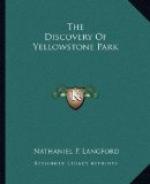This long fight made evident the dangers
to which the
Park was exposed, and showed the necessity
of additional
legislation.
A bill to protect the Park was drawn by Senator Vest and passed by Congress, and from that time on, until the day of his retirement from public life, Senator Vest was ever a firm and watchful guardian of the Yellowstone National Park, showing in this matter, as in many others, “the highest patriotism and statesmanship.” For many years, from 1882 to 1894, Senator Vest remained the chief defender of a National possession that self-seeking persons in many parts of the country were trying to use for their own profit.
[Illustration: W. Hallett Phillips]
[Illustration: George Graham Vest.]
If we were asked to mention the two men who did more than any other two men to save the National Park for the American people, we should name George Graham Vest and William Hallett Phillips, co-workers in this good cause. There were other men who helped them, but these two easily stand foremost.
In the light of the present glorious development of the Park it can be said of each one who has taken part in the work of preserving for all time this great national pleasuring ground for the enjoyment of the American people, “He builded better than he knew.”
An amusing feature of the identity of my name with the Park was that my friends, with a play upon my initials, frequently addressed letters to me in the following style:
[Illustration: National Park Langford]
The fame of the Yellowstone National Park, combining the most extensive aggregation of wonders in the world—wonders unexcelled because nowhere else existing—is now world-wide. The “Wonderland” publications issued by the Northern Pacific Railway, prepared under the careful supervision of their author, Olin D. Wheeler, with their superb illustrations of the natural scenery of the park, and the illustrated volume, “The Yellowstone,” by Major Hiram M. Chittenden, U.S. Engineers, under whose direction the roads and bridges




